| |||||
| Decades: | |||||
|---|---|---|---|---|---|
| See also: | |||||

Events from the year 1744 in Austria
| |||||
| Decades: | |||||
|---|---|---|---|---|---|
| See also: | |||||

Events from the year 1744 in Austria
| | This section needs expansion. You can help by adding to it. (October 2015) |
| | This section needs expansion. You can help by adding to it. (October 2015) |
| | This section needs expansion. You can help by adding to it. (October 2015) |

Maria Theresa was ruler of the Habsburg dominions from 1740 until her death in 1780, and the only woman to hold the position suo jure. She was the sovereign of Austria, Hungary, Croatia, Bohemia, Transylvania, Slavonia, Mantua, Milan, Moravia, Galicia and Lodomeria, Dalmatia, the Austrian Netherlands, and Parma. By marriage, she was Duchess of Lorraine, Grand Duchess of Tuscany, and Holy Roman Empress.
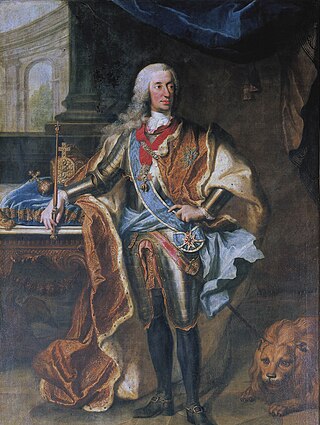
Charles VII was elector of Bavaria from 26 February 1726 and Holy Roman Emperor from 24 January 1742 to his death. He was also King of Bohemia from 1741 to 1743. Charles was a member of the House of Wittelsbach, and his reign as Holy Roman Emperor thus marked the end of three centuries of uninterrupted Habsburg imperial rule, although he was related to the Habsburgs by both blood and marriage.

The War of the Austrian Succession was a European conflict fought between 1740 and 1748, primarily in Central Europe, the Austrian Netherlands, Italy, the Atlantic Ocean and Mediterranean Sea. Related conflicts include King George's War in North America, the War of Jenkins' Ear, the First Carnatic War, and the First and Second Silesian Wars.
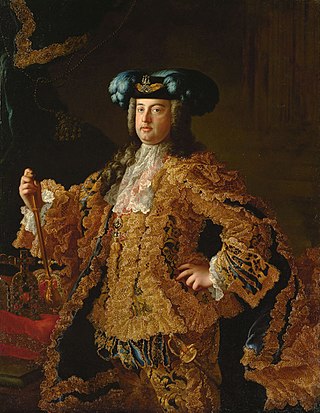
Francis I was Holy Roman Emperor from 1745 to 1765, Archduke of Austria from 1740 to 1765, Duke of Lorraine and Bar from 1729 to 1737, and Grand Duke of Tuscany from 1737 to 1765. He became the ruler of the Holy Roman Empire, Austria, and Tuscany through his marriage to his second cousin Maria Theresa of Austria, daughter of Emperor Charles VI. Francis was the last non-Habsburg monarch of the Empire. The couple were the founders of the Habsburg-Lorraine dynasty, and their marriage produced sixteen children.

Charles VI was Holy Roman Emperor and ruler of the Austrian Habsburg monarchy from 1711 until his death, succeeding his elder brother, Joseph I. He unsuccessfully claimed the throne of Spain following the death of his relative, Charles II. In 1708, he married Elisabeth Christine of Brunswick-Wolfenbüttel, by whom he had his four children: Leopold Johann, Maria Theresa, Maria Anna, and Maria Amalia.
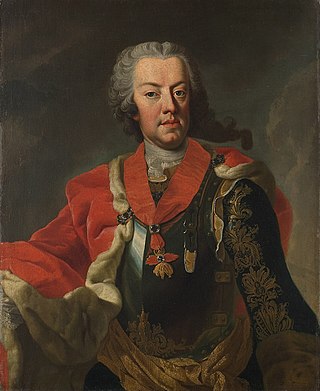
Prince Charles Alexander Emanuel of Lorraine was a Lorraine-born Austrian general and soldier, field marshal of the Imperial Army, and governor of the Austrian Netherlands.

The Silesian Wars were three wars fought in the mid-18th century between Prussia and Habsburg Austria for control of the Central European region of Silesia. The First (1740–1742) and Second (1744–1745) Silesian Wars formed parts of the wider War of the Austrian Succession, in which Prussia was a member of a coalition seeking territorial gain at Austria's expense. The Third Silesian War (1756–1763) was a theatre of the global Seven Years' War, in which Austria in turn led a coalition of powers aiming to seize Prussian territory.
The Treaty of Worms was a political alliance formed between Great Britain, Austria and the Kingdom of Sardinia, signed on 13 September 1743, during the War of the Austrian Succession.

The Second Silesian War was a war between Prussia and Austria that lasted from 1744 to 1745 and confirmed Prussia's control of the region of Silesia. The war was fought mainly in Silesia, Bohemia, and Upper Saxony and formed one theatre of the wider War of the Austrian Succession. It was the second of three Silesian Wars fought between Frederick the Great's Prussia and Maria Theresa's Austria in the mid-18th century, all three of which ended in Prussian control of Silesia.
Maria of Habsburg may refer to:

Archduchess Maria Anna Eleonore Wilhelmine Josepha of Austria was a member of the House of Habsburg who governed the Austrian Netherlands in the name of her elder sister, Empress Maria Theresa.

Elisabeth Christine of Brunswick-Wolfenbüttel was Princess of Brunswick-Wolfenbüttel, Holy Roman Empress, German Queen, Queen of Bohemia and Hungary; and Archduchess of Austria by her marriage to Charles VI, Holy Roman Emperor. She was renowned for her delicate beauty and also for being the mother of Empress Maria Theresa. She was the longest serving Holy Roman Empress.
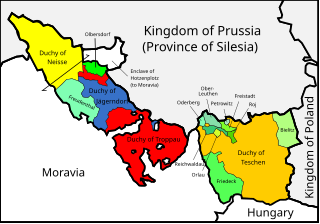
The Treaty of Berlin was a treaty between the Habsburg archduchess Maria Theresa of Austria, who was also Queen of Bohemia, and the Prussian king Frederick the Great, signed on 28 July 1742 in Berlin. It was the formal peace treaty that confirmed the preliminary agreement achieved with English mediation by the 11 June Treaty of Breslau, and officially ended the First Silesian War.

Élisabeth Charlotte d'Orléans was a petite-fille de France and duchess of Lorraine and Bar by her marriage to Duke Leopold. She was regent of the duchy during the minority (1729–1730) and absence (1730–1737) of her son and suo jure princess of Commercy from 1737–1744. Among her children was Francis I, Holy Roman Emperor, the co-founder of the House of Habsburg-Lorraine.
Archduchess Maria may refer to a number of historical noblewomen of Austria:
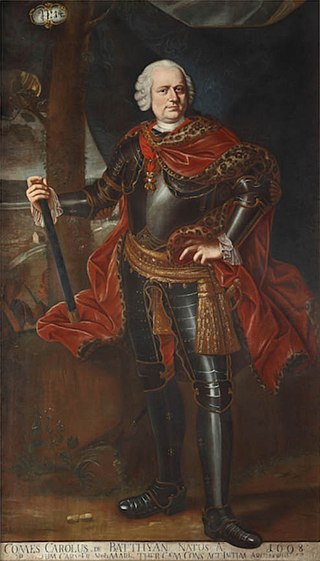
Count Károly József Batthyány of Németújvár was a Hungarian general and field marshal. He served as ban (viceroy) of Croatia from 1743 to 1756.

Infanta Maria Theresa of Portugal was a Princess of the House of Braganza. She became by marriage an Archduchess of Austria and also sister-in-law of Emperors Franz Joseph I of Austria and Maximilian I of Mexico, as well as step-grandmother of Emperor Charles I of Austria.

Martin van Meytens was a Swedish-Austrian painter who painted members of the Royal Court of Austria such as Marie Antoinette, Maria Theresa of Austria, Francis I, Holy Roman Emperor, the Emperor's family and members of the local aristocracy. His painting style inspired many other painters to paint in a similar format.

Wenzel Anton, Prince of Kaunitz-Rietberg was an Austrian and Czech diplomat and statesman in the Habsburg monarchy. A proponent of enlightened absolutism, he held the office of State Chancellor for about four decades and was responsible for the foreign policies during the reigns of Maria Theresa, Joseph II, and Leopold II. In 1764, he was elevated to the noble rank of a Prince of the Holy Roman Empire (Reichfürst).

Count Anton Corfiz von Ulfeldt was an Austrian politician and diplomat of Danish descent.
![]() Media related to 1744 in Austria at Wikimedia Commons
Media related to 1744 in Austria at Wikimedia Commons